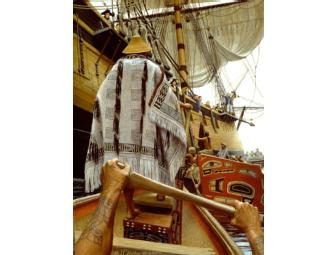GANNYAA AND JUAN P??A?REZ 17 X 22 Giclee Print by Bill Holm

Item Number: 166
Time Left: CLOSED
Description
Giclée print in archival inks on acid- and lignin-free paper
Original painting in acrylic on canvas 24” X 18” 2000
Collection of Robin Wright
On the afternoon of July 20, 1774, 21 canoes bearing 150 Haida people clustered around the becalmed frigate Santiago to trade with the strange foreigners who had suddenly, the day before, sailed into their home waters. Fortunately for us, the ship’s captain, Juan Pérez, his second officer Esteban José Martinez, and two chaplains aboard, Fr. Tomás de la Peña and Fr. Juan Crespi, all kept journals describing the events of those two days. Fortunate, because this was the first recorded contact between Europeans and Northwest Coast Natives, and because the journals all contain descriptions of the people and their actions. The meeting took place at the north side of Langara Island, the northwestern-most of the Queen Charlotte Islands, in present-day British Columbia. Although Pérez wanted to anchor and go ashore, adverse currents, weather, and an uncertain shore prevented him from doing so, and in the evening, as the wind freshened, he sailed to the northwest across Dixon entrance. He sighted Cape Muzon, the southern tip of Southeastern Alaska, before turning south again toward his base at Monterey.
The accounts of Pérez, Martinez, and the two chaplains record the appearance, dress, canoes, and paraphernalia of the Haida who crowded around the ship. The ceremonial dancing and singing before and after the trading session were described by them, as well as the trading itself, which gave the Spaniards the distinct impression that the Haida were very experienced at it. A good many objects, including hats, robes of fur or woven of mountain goat wool, carved chests, and weapons, were among the souvenirs traded for old clothes, knives and beads. Only two of these artifacts are known to have survived- a hat woven of spruce root and a small, exquisitely carved ivory bird, traded from a woman who carried it in a basketry pouch. Both are now in the Muséo de America in Madrid. The journals are the first to describe the use of labrets by Northwest Coast women, and that they wore bracelets of iron and copper. One older man among the Haidas was clearly the “chief or captain.” Though his name was not recorded until fifteen years later, it is possible that this was Gannyaa, the most powerful leader of the Northern Haida according to late nineteenth century accounts. I have shown him in the bow of his great canoe, overseeing commerce between his people and the occupants of the huge and strange vessel so suddenly appearing in his country.
I’m very much indebted to Mark Myers, PRSMA, F/ASMA, an outstanding marine artist and authority on 18th century ships and sailing, for his generous advice on those aspects of the painting.